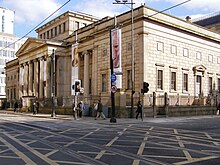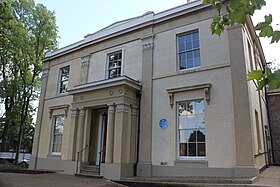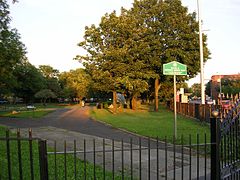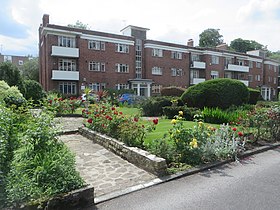Welcome to Visit Manchester Places
The Walkfo guide to things to do & explore in Manchester
![]() Visit Manchester places using Walkfo for free guided tours of the best Manchester places to visit. A unique way to experience Manchester’s places, Walkfo allows you to explore Manchester as you would a museum or art gallery with audio guides.
Visit Manchester places using Walkfo for free guided tours of the best Manchester places to visit. A unique way to experience Manchester’s places, Walkfo allows you to explore Manchester as you would a museum or art gallery with audio guides.
Visiting Manchester Walkfo Preview
Manchester is a city and metropolitan borough in Greater Manchester, England . The city has the country’s fifth-largest population at 547,627 (as of 2018) and lies within the United Kingdom’s second-most populous urban area, with a population of 2.7 million . It is fringed by the Cheshire Plain to the south, the Pennines to the north and east, and an arc of towns with which it forms a continuous conurbation . The recorded history of Manchester began with the civilian settlement associated with the Roman fort of Mamucium or Mancunium, which was established in about AD 79 . When you visit Manchester, Walkfo brings Manchester places to life as you travel by foot, bike, bus or car with a mobile phone & headphones.
Manchester Places Overview: History, Culture & Facts about Manchester
Visit Manchester – Walkfo’s stats for the places to visit
With 468 audio plaques & Manchester places for you to explore in the Manchester area, Walkfo is the world’s largest heritage & history digital plaque provider. The AI continually learns & refines facts about the best Manchester places to visit from travel & tourism authorities (like Wikipedia), converting history into an interactive audio experience.
Manchester history
Early history
The Brigantes were the major Celtic tribe in what is now known as Northern England . They had a stronghold in the locality at a sandstone outcrop on which Manchester Cathedral now stands . Roman habitation of Manchester probably ended around the 3rd century . Manchester is mentioned as having a market in 1282 .
Industrial Revolution
Manchester was one of the centres of textile manufacture during the Industrial Revolution. The great majority of cotton spinning took place in the towns of south Lancashire and north Cheshire, and Manchester was for a time the most productive centre of cotton processing. Manchester became known as the world’s largest marketplace for cotton goods and was dubbed “Cottonopolis” and “Warehouse City” during the Victorian era. In Australia, New Zealand and South Africa, the term “manchester” is still used for household linen: sheets, pillow cases, towels, etc. The industrial revolution brought about huge change in Manchester and was key to the increase in Manchester’s population. Manchester began expanding “at an astonishing rate” around the turn of the 19th century as people flocked to the city for work from Scotland, Wales, Ireland and other areas of England as part of a process of unplanned urbanisation brought on by the Industrial Revolution. It developed a wide range of industries, so that by 1835 “Manchester was without challenge the first and greatest industrial city in the world.” Engineering firms initially made machines for the cotton trade, but diversified into general manufacture. Similarly, the chemical industry started by producing bleaches and dyes, but expanded into other areas. Commerce was supported by financial service industries such as banking and insurance. Trade, and feeding the growing population, required a large transport and distribution infrastructure: the canal system was extended, and Manchester became one end of the world’s first intercity passenger railway—the Liverpool and Manchester Railway. Competition between the various forms of transport kept costs down. In 1878 the GPO (the forerunner of British Telecom) provided its first telephones to a firm in Manchester. The Manchester Ship Canal was built between 1888 and 1894, in some sections by canalisation of the Rivers Irwell and Mersey, running 36 miles (58 km) from Salford to Eastham Locks on the tidal Mersey. This enabled oceangoing ships to sail right into the Port of Manchester. On the canal’s banks, just outside the borough, the world’s first industrial estate was created at Trafford Park. Large quantities of machinery, including cotton processing plant, were exported around the world. A centre of capitalism, Manchester was once the scene of bread and labour riots, as well as calls for greater political recognition by the city’s working and non-titled classes. One such gathering ended with the Peterloo massacre of 16 August 1819. The economic school of Manchester Capitalism developed there, and Manchester was the centre of the Anti-Corn Law League from 1838 onward. Manchester has a notable place in the history of Marxism and left-wing politics; being the subject of Friedrich Engels’ work The Condition of the Working Class in England in 1844; Engels spent much of his life in and around Manchester, and when Karl Marx visited Manchester, they met at Chetham’s Library. The economics books Marx was reading at the time can be seen in the library, as can the window seat where Marx and Engels would meet. The first Trades Union Congress was held in Manchester (at the Mechanics’ Institute, David Street), from 2 to 6 June 1868. Manchester was an important cradle of the Labour Party and the Suffragette Movement. At that time, it seemed a place in which anything could happen—new industrial processes, new ways of thinking (the Manchester School, promoting free trade and laissez-faire), new classes or groups in society, new religious sects, and new forms of labour organisation. It attracted educated visitors from all parts of Britain and Europe. A saying capturing this sense of innovation survives today: “What Manchester does today, the rest of the world does tomorrow.” Manchester’s golden age was perhaps the last quarter of the 19th century. Many of the great public buildings (including Manchester Town Hall) date from then. The city’s cosmopolitan atmosphere contributed to a vibrant culture, which included the Hallé Orchestra. In 1889, when county councils were created in England, the municipal borough became a county borough with even greater autonomy. Although the Industrial Revolution brought wealth to the city, it also brought poverty and squalor to a large part of the population. Historian Simon Schama noted that “Manchester was the very best and the very worst taken to terrifying extremes, a new kind of city in the world; the chimneys of industrial suburbs greeting you with columns of smoke”. An American visitor taken to Manchester’s blackspots saw “wretched, defrauded, oppressed, crushed human nature, lying and bleeding fragments”. The number of cotton mills in Manchester itself reached a peak of 108 in 1853. Thereafter the number began to decline and Manchester was surpassed as the largest centre of cotton spinning by Bolton in the 1850s and Oldham in the 1860s. However, this period of decline coincided with the rise of the city as the financial centre of the region. Manchester continued to process cotton, and in 1913, 65% of the world’s cotton was processed in the area. The First World War interrupted access to the export markets. Cotton processing in other parts of the world increased, often on machines produced in Manchester. Manchester suffered greatly from the Great Depression and the underlying structural changes that began to supplant the old industries, including textile manufacture.
Blitz
Like most of the UK, the Manchester area was mobilised extensively during the Second World War . Manchester was the target of bombing by the Luftwaffe, and by late 1940 air raids were taking place against non-military targets . The biggest took place during the Christmas Blitz, when an estimated 474 tonnes (467 long tons) of high explosives plus over 37,000 incendiary bombs were dropped .
Post-Second World War
Manchester has a history of attacks attributed to Irish Republicans, including the Manchester Martyrs of 1867, arson in 1920, a series of explosions in 1939, and two bombs in 1992 . Heavy industry suffered a downturn from the 1960s and was greatly reduced under the economic policies followed by Margaret Thatcher’s government after 1979 . Manchester lost 150,000 jobs in manufacturing between 1961 and 1983 .
Since 2000
The city centre has undergone extensive regeneration after the 1996 bomb and aided by the XVII Commonwealth Games . Large city sections from the 1960s have been demolished, re-developed or modernised . Beetham Tower was the tallest UK building outside London and the highest residential accommodation in Europe when completed in 2006 .
Manchester culture & places
Music

Bands that have emerged from the Manchester music scene include Van der Graaf Generator, Oasis, The Smiths, Joy Division, Buzzcocks, The Stone Roses, The Fall, 10cc, Godley & Creme, The Verve, Elbow, Doves, The Charlatans, M People, The 1975, Simply Red, Take That, Dutch Uncles, Everything Everything, Pale Waves and The Outfield . Manchester was credited as the main driving force behind British indie music of the 1980s .
Performing arts

Manchester has a thriving theatre, opera and dance scene, with a number of large performance venues . The city has hosted the Manchester International Festival, a biennial international arts festival with a focus on original work . A government statement in 2014 announced a £78 million grant for a new “large-scale, ultra-flexible arts space” for the city . The £110 million venue, The Factory, will provide a permanent home for the festival .
Museums and galleries

The Science and Industry Museum has a large collection of steam locomotives, industrial machinery, aircraft and a replica of the world’s first stored computer program (known as the Manchester Baby) Manchester Art Gallery in Mosley Street houses a permanent collection of European painting and one of Britain’s main collections of Pre-Raphaelite paintings . Whitworth Art Gallery was voted Museum of the Year in 2015 .
Literature

Manchester is a UNESCO City of Literature known for a ‘radical literary history’ It featured in works highlighting the changes that industrialisation had brought . Charles Dickens is reputed to have set his novel Hard Times in the city . Charlotte Brontë began writing Jane Eyre in 1846, while staying at lodgings in Hulme .
Nightlife
The night-time economy of Manchester has expanded significantly since 1993 . The more than 500 licensed premises in the city centre have a capacity to deal with more than 250,000 visitors . Manchester is the most popular city for events at 79 per thousand people .
Gay village
Canal Street area has had an LGBTQ+ clientele since at least 1940 . Canal Street attracts 20,000 visitors each weekend and has hosted a popular festival, Manchester Pride, each August since 1995 .
Manchester etymology
The name Manchester originates from the Latin name Mamucium or its variant Mancunio. Citizens are still referred to as ‘Mancunians’ The name is generally thought to represent a Latinisation of an original Brittonic name.
Manchester landmarks

The widespread use of red brick characterises the city, much of the architecture of which harks back to its days as a global centre for the cotton trade. The award-winning Heaton Park in the north of the city borough is one of the largest municipal parks in Europe, covering 610 acres (250 ha) of parkland.
Manchester geography / climate
Manchester lies 160 miles (260 km) northwest of London. It lies in a bowl-shaped land area bordered to the north and east by the Pennines. The city centre is on the east bank of the River Irwell, near its confluences with the Rivers Medlock and Irk. The M60 and M56 motorways pass through Northenden and Wythenshawe in the south.
Climate
Manchester experiences a temperate oceanic climate (Köppen: Cfb), like much of the British Isles, with warm summers and cool winters . Summer daytime temperatures regularly top 20 Celsius, often reaching 25 Celsius on sunny days during July and August in particular . The lowest temperature ever recorded in Manchester was −17.6 °C (0.3 °F) on 7 January 2010 .
Why visit Manchester with Walkfo Travel Guide App?
![]() You can visit Manchester places with Walkfo Manchester to hear history at Manchester’s places whilst walking around using the free digital tour app. Walkfo Manchester has 468 places to visit in our interactive Manchester map, with amazing history, culture & travel facts you can explore the same way you would at a museum or art gallery with information audio headset. With Walkfo, you can travel by foot, bike or bus throughout Manchester, being in the moment, without digital distraction or limits to a specific walking route. Our historic audio walks, National Trust interactive audio experiences, digital tour guides for English Heritage locations are available at Manchester places, with a AI tour guide to help you get the best from a visit to Manchester & the surrounding areas.
You can visit Manchester places with Walkfo Manchester to hear history at Manchester’s places whilst walking around using the free digital tour app. Walkfo Manchester has 468 places to visit in our interactive Manchester map, with amazing history, culture & travel facts you can explore the same way you would at a museum or art gallery with information audio headset. With Walkfo, you can travel by foot, bike or bus throughout Manchester, being in the moment, without digital distraction or limits to a specific walking route. Our historic audio walks, National Trust interactive audio experiences, digital tour guides for English Heritage locations are available at Manchester places, with a AI tour guide to help you get the best from a visit to Manchester & the surrounding areas.
“Curated content for millions of locations across the UK, with 468 audio facts unique to Manchester places in an interactive Manchester map you can explore.”
Walkfo: Visit Manchester Places Map
468 tourist, history, culture & geography spots
Manchester historic spots | Manchester tourist destinations | Manchester plaques | Manchester geographic features |
| Walkfo Manchester tourism map key: places to see & visit like National Trust sites, Blue Plaques, English Heritage locations & top tourist destinations in Manchester | |||
Best Manchester places to visit
Manchester has places to explore by foot, bike or bus. Below are a selection of the varied Manchester’s destinations you can visit with additional content available at the Walkfo Manchester’s information audio spots:
 | Longsight Electric TMD Longsight Electric TMD is an AC electric railway locomotive traction maintenance depot situated in Longsight, Manchester, England . The depot code is LG (9A 1950 – 1973). It is one of the largest train depots in the United Kingdom and can hold 179 carriages at one time . |
 | Victoria Baths Victoria Baths opened to the public in 1906 and cost £59,144 to build . Manchester City Council closed the baths in 1993 and the building was left empty . A multimillion-pound restoration project began in 2007 and is on English Heritage’s Heritage at Risk Register . |
 | Edgar Wood Centre Edgar Wood Centre was designed by Edgar Wood in 1903 . Nikolaus Pevsner considered it “the only religious building in Lancashire that would be indispensable in a survey of twentieth century church design in all England” Grade I listed building is on Heritage at Risk Register . |
 | Victoria Park, Manchester Victoria Park is a suburban area of Manchester, England . Victoria Park lies approximately two miles south of Manchester city centre . It is located between Rusholme and Longsight . |
 | Dalton-Ellis Hall Dalton-Ellis Hall is a hall of residence complex at the University of Manchester . It is situated in the south of the city on Conyngham Road in Victoria Park, next to St Chrysostom’s Church . It has 279 male and female residents in catered accommodation . |
 | Ardwick Ardwick is a district of Manchester in North West England, one mile south east of the city centre . The population of the Ardwick Ward at the 2011 census was 19,250 . Historically in Lancashire, by the mid-nineteenth century Ardwick had grown from being a village into a wealthy suburb of Manchester . By the end of that century it had become heavily industrialised . |
 | O2 Apollo Manchester The O2 Apollo Manchester is a concert venue in Ardwick Green, Manchester . It is a Grade II listed building with a capacity of 3,500 (2,514 standing, 986 seats) |
 | Centre for Pharmacy Postgraduate Education The Centre for Pharmacy Postgraduate Education (CPPE) is part of the Manchester Pharmacy School, in the University of Manchester . In May 1991, CPPE was created as a direct response to the perceived lack of continuing professional development support given to community pharmacists . |
 | Appleby Lodge Appleby Lodge is a set of three-storey 1930s blocks of flats with eight entrance doors . The blocks are in a U-shape around a central garden in Rusholme, Manchester . |
 | Department of Earth and Environmental Sciences, University of Manchester The Department of Earth and Environmental Sciences at The University of Manchester is one of the oldest earth and environmental science departments in the UK . The Department takes roughly 100 new undergraduates and 140 postgraduates each year . |
Visit Manchester plaques
![]() 181
181
plaques
here Manchester has 181 physical plaques in tourist plaque schemes for you to explore via Walkfo Manchester plaques audio map when visiting. Plaques like National Heritage’s “Blue Plaques” provide visual geo-markers to highlight points-of-interest at the places where they happened – and Walkfo’s AI has researched additional, deeper content when you visit Manchester using the app. Experience the history of a location when Walkfo local tourist guide app triggers audio close to each Manchester plaque. Explore Plaques & History has a complete list of Hartlepool’s plaques & Hartlepool history plaque map.
